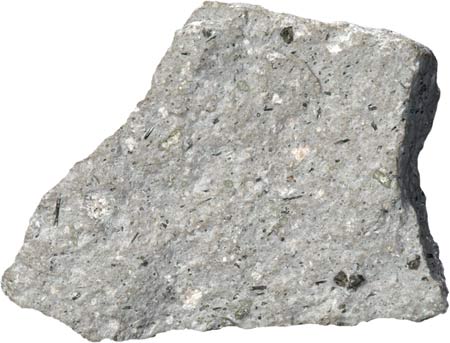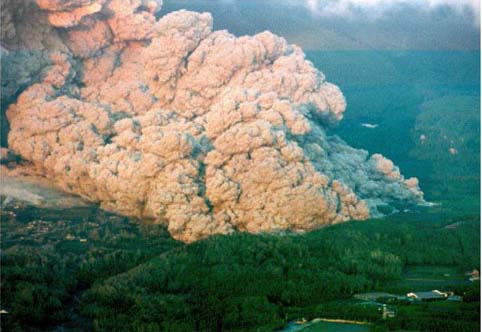So, I've had requests on the blog to help to do some defining of volcanologic terms on the blog, so I thought I'd try a new column called Eruptions Word of the Day. I'm not sure how often it will run, but let's give it a try.
Eruptions Word of the Day for July 5, 2010: Dacite
Dacite is a magma type defined by silica (SiO2) content between 63-68 (or 69) weight percent. That is the textbook definition, but some other typical characteristics of dacite lavas (or magmas) is the presence of certain minerals: plagioclase feldspar and hydrous minerals (containing water in their mineral structure) such as amphibole (typically hornblende) or biotite mica. If the dacite is hot and dry (lacking in water), you would expect to find pyroxene in the lava as well, although it is common in almost all dacites that even have hydrous minerals. Typically, dacite erupt anywhere from 800 to 1000 degrees Celsius. The intrusive equivalent for a dacite is granodiorite.

Dacite lava hand sample, with abundant amphibole and plagioclase feldspar.
Dacite is found in a wide variety of tectonic settings but is most common in continental subduction zone/arc settings, such as the Andes or the Cascades. They tend to be products of magma mixing or crustal assimilation (by another magma) to form the dacite. The types of eruptions that dacite magma produces can vary from lava flows and domes (effusive, passive eruptions) to explosive, plinian-style eruptions - but they are most famous for the explosive eruptions like Mount St. Helens, Lassen Peak and Unzen in Japan (see below).

Pyroclastic flows from Mt. Unzen in Japan. A flow like this killed the Kraffts in 1991.
However, there are impressive effusive dacite lavas flows, such as the Chao Dacite and Volcan Aucanquilcha (see below) in Chile and Llao Rock at Crater Lake, where minor explosive deposits preceded the lava flows that stretch upwards of 5-10 km from the vent. These lava flows are usually steep-sided with well-formed levees on the sides and pressure ridges along the flow tops (see below). It is thought that dacite lava flows or domes form when the magma is allowed to degas before erupting, allowing for a passive rather than explosive eruption.
Dacite lava flows on Volcan Aucanquilcha, Chile. Note the steep sides of the flows coming from from the main summit. Click on the image to see a larger version. Image by Erik Klemetti.
Dacite tend to be a "garbage bag" of minerals - they have collected a variety of crystals from different sources. These sources include the active magma of the eruption in question (phenocrysts), crystals from previous magmatism at the volcano (antecrysts) and wholly unrelated crystals (xenocrysts). This mixing creates disequilibrium, where minerals only stable in one condition find themselves in another, creating impressive reaction textures (see below). This variety of crystals supports the ideas that many dacites are the product of magma mixing.
Amphibole crystal breaking down in a mixed dacite from Volcan Aucanquilcha, Chile. The interior is cored with biotite mica, iron-titanium oxide (such as magnetite), and quartz, while the outer roughly hexagonal shape is amphibole. The clear crystals along the edge of the grain are formed from the breakdown of the larger amphibole crystal when it is in disequilibrium. Click on the image to see a larger version. Image by Erik Klemetti.
- Log in to post comments





Erik, it might not be a bad idea, when describing a rock like this, to give the names for equivalent composition medium and coarse grained intrusives.
Excellent idea Erik!!
This is exactly what I need!
Very nice post. I would also add that the word "Dacite" comes from Dacia, an ancient land north of the Danube, in an area of what is now Romania. It was first described in Romania (Romanian word is spelled "Dacit") in the Neogene volcanic complex of the Eastern Carpathians.
Oh, good stuff! Thanks.
Gee, this is great. It's just like being an undergrad again. No wonder I was happy then, with the earth divided into reasonable chunks of rock and unreasonable time periods. There's something so comforting about mineralogy and petrology and all matters geologic in a world of idiotic politics, wars, and pop culture. I'm serious! Whenever I feel confused I go out in the field and ponder erosion features, stream gradients, and rubble deposits, and lug home metamorphic cobbles, which are the most mysterious objects I know of. No kidding!
Yes, thank you for the definition, added to my definitions folder. :-)
Good point, Fireman. I've added this to the definition.
Great idea and work to get these main volcanic features together like in an encyclopedia!
Fantastic, Erik! Great idea to have the definitions and pictures of what you are talking about. Although I took geology, that was forty years ago and I have forgotten a lot of it.
@Bo Moore #5, I can't agree with you more! My DH and I like to go to the river early when no one else is there and it is so peaceful. We like to pan for gold and check out the rock in the river. We see a lot of different things in the river such as lava bombs and jasper. A lot of quartz and limestone. Once in a while you will have a really cool find as I did at a confluence of two forks of the river: a fairly large rock of yellow jasper. I intended to take it out and forgot it. I could kick myself for that one.
I have a metamorphic rock I took out of an ignious dike. I showed it to my geology teachers and they told me it was metamorphic and when I told them where I got it, they didn't believe me. The dike was a place they sent all of us to see what it was like and I found that rock in the dike. It was different and I kept telling them it was from the dike. They were puzzled by that one.
Erik, when you talk about "hydrous minerals (containing water in their mineral structure)" I understand that water molecules take part of the chemical structure, am I correct? Different from free water bubbles mixed in explosive viscous magmas? If so, does this chemically-bound water take part on the "explosiveness" of the extruding lava?
2010-07-05 14:50:45.6 (2hr 20min ago) 71.67 N 5.35 W 2km4.3 - JAN MAYEN ISLAND REGION
(http://www.emsc-csem.org/index.php?page=home#2)
This EQ hasn't yet be confirmed by USGS
Be careful about picking up rocks! : 0 ;)
05/07/2010 | 08:00 Iceland Review
Jinxed Lava Nugget Returned
A British tourist has returned a piece of lava which he removed without permission, visir.is reports. He believed the stone to be the source of all his recent calamities. The lava has now been returned, flown by helicopter to the eruption site at Eyjafjallajökull glacier.
After suffering blows both in his private and professional life, the tourist decided to send the nugget to the University of Icelandâs Institute of Earth Sciences, requesting that it be returned to its proper place.
âHe was not joking,â said Rikke Pedersen, a specialist at the institution. âHe had been traveling around Iceland with his family and since then, all kinds of bad things began happening to him. He was convinced that if he returned the nugget, everything would return to normal.â
Pedersen received the rock along with a letter explaining the situation. This week, she brought it to the Iceland Tourist Assistance. There, the staff got in touch with Nordurflug Flight Company who flew it to the eruption site, which contains Icelandâs freshest lava.
In Iceland, rocks are part of the folklore.
Excellent! like #4 this is a nice escape into the world of an
undergrad, I almost switched my major to Geology, but didn't.
I probably wouldn't have used the Degree anyway like I didn't use my B.S. in Biology...
>I have a metamorphic rock I took out of an igniousigneous dike
Could be evidence of contact metamorphism, where hot igneous intrusion(some 1200 degrees C) heats host rock, transforming it. It occurs at shallow depths.
It's not a new concept (dates to early 20th century), and has been described for small intrusions as well as large plutons.
Maybe your rock was displaced and carried to the location you found it, which caused some confusion over it's origin.
Nice question Renato! As a quick answer: yes and no. I'll start with the "no" - the molecular water in the crystalline structure doesn't directly take part in making an eruption explosive as such as it is bound up in the crystal (not as bubbles in the mineral or magma). However, usually it takes higher water content in the magma (as bubbles when they exsolve/come out of solution) for these minerals to form in the first place, so the "yes" is that hydrous minerals are a marker for water/volatile-rich magma.
Often or not, useful most certainly.
Aside: Up here, 'lÃparÃt' (derived from Lipari) is a term used for silica-rich types like rhyolite, dacite and benmoreite, according to a glossary my sister bought last week.
#15 Thank, you Erik. I've been struggling with this question for a long time. Eagerly waiting for another "word of the day". Thanks again.
Does anyone knew why
http://www.intlvrc.org/news.htm
dosen't work any more?
Walter, I'm guessing it has something to do with this ongoing saga:
http://blogs.phoenixnewtimes.com/valleyfever/2010/06/arizona_republic_a…
Thanks for the post, Eric, keep them coming.
Let's try a slightly different approach.
You got your basic tool chest volcanology glossary from SI-GVP.
vulcan.wr.usgs.gov/Glossary/volcano_terminology.html
Oregon State also has one:
volcano.oregonstate.edu/education/glossary.html
The problem with these glossaries is that the definitions are a tad too brief, and the explanation pages (hyperlinked on GVP) are WAAAAY too complex.
Enter Erik, with his explanatory pages.
You ask Lee at GVP, real nicey nicey, if you can collaborate on a little NSF education proposal, to provide an *intermediate* level of technical term definitions in an online format. The individual term def pages are provided piecemeal by you, Erik, through a serial posting on this website and they are permanently hosted by SI-GVP.
I like the idea of your def webpages getting feedback from the professionals via this forum. That way, you got your bases covered with respect to covering the important bits.
It would also be good to see these def pages hosted on a more permanent platform like GVP, rather than on a blog.
I see that as a win-win situation for you and SI.
I've been doing some catching up on the last few days... Thanks to Raving on June 30, I followed your link, and EMF theory and methodology are now much clearer to me and I now know what a nano Tesla is! It will be interesting to see if they can get back to Volcano Island in October for the next planned study.
July 1 comments were fantastic, that one day alone would have hooked me into "Eruptions" even without an ongoing eruption to follow.
I like Carl's idea of vorticity in the mantle. The idea that a vortex could become self generating by pulling in colder mantle material and then warming it by friction makes some sort of sense. Hurricanes can grow by pulling in warm air from the water surface, and firestorms, manmade or natural, by pulling in cold oxygen rich air to fuel the central combustion. Both are vortices but in a different medium and timescale.
Great idea Erik. Petrology was more than 20 years ago for me, so the review is much appreciated.
Dear Eruptions: Have being looking in I.T. for a web site or page in which it appears Volcanology terms abbreviate for example:V.E.I.= Volcan Explosivite Index.
Thank You very much.
Sincerely Yours.
Frojan, J.J.